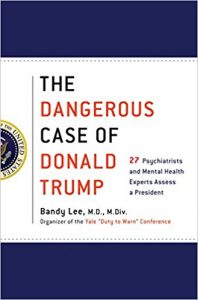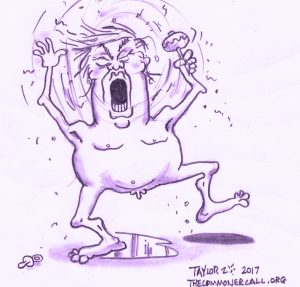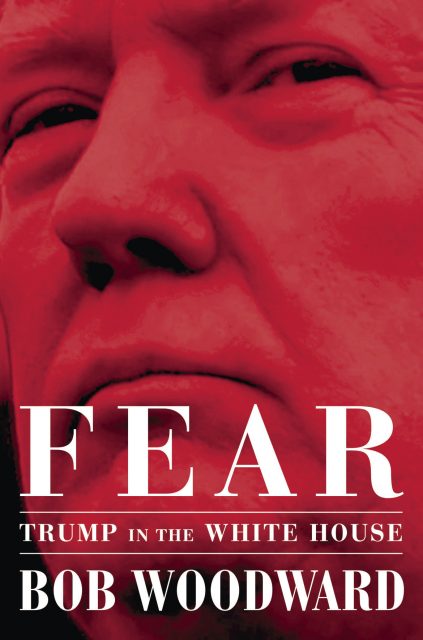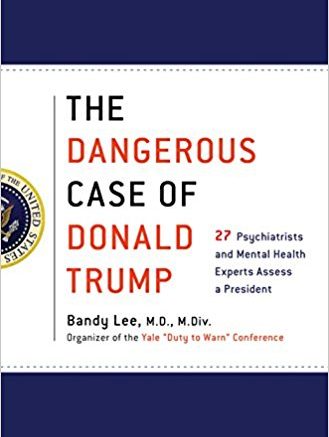
By Brandy X. Lee
The Conversation (9/6/18)
Bob Woodward’s new book, “Fear,” describes a “nervous breakdown of Trump’s presidency.” Earlier this year, Michael Wolff’s “Fire and Fury” offered a similar portrayal.
Now, an op-ed in The New York Times by an anonymous “senior White House official” describes how deeply the troubles in this administration run and what effort is required to protect the nation.
None of this is a surprise to those of us who, 18 months ago, put together our own public service book, “The Dangerous Case of Donald Trump: 27 Psychiatrists and Mental Health Experts Assess a President.”
My focus as the volume’s editor was on Trump’s dangerousness because of my area of expertise in violence prevention. Approaching violence as a public health issue, I have consulted with governments and international organizations, in addition to 20 years of engaging in the individual assessment and treatment of violent offenders.
The book proceeded from an ethics conference I held at Yale, my home institution. At that meeting, my psychiatrist colleagues and I discussed balancing two essential duties of our profession. First is the duty to speak responsibly about public officials, especially as outlined in “the Goldwater rule,” which requires that we refrain from diagnosing without a personal examination and without authorization. Second is our responsibility to protect public health and safety, or our “duty to warn” in cases of danger, which usually supersedes other rules.

We are already witnessing a further unraveling of the president’s mental state, especially as the frequency of his lying increases and the fervor of his rallies intensifies.
Our conclusion was overwhelmingly that our responsibility to society and its safety, as outlined in our ethical guidelines, overrode any etiquette owed to a public figure. That decision led to the collection of essays in the book, which includes some of the most prominent thinkers of the field including Robert J. Lifton, Judith Herman, Philip Zimbardo and two dozen others. That decision was controversial among some members of our field.
We already know a great deal about Trump’s mental state based on the voluminous information he has given through his tweets and his responses to real situations in real time. Now, this week’s credible reports support the concerns we articulated in the book beyond any doubt.
The psychology behind the chaos
The author of the New York Times op-ed makes clear that the conflict in the White House is not about Trump’s ideology.
The problem, the author sees, is the lack of “any discernible first principles that guide his decision making … his impulsiveness [that] results in half-baked, ill-informed and occasionally reckless decisions that have to be walked back, and there being literally no telling whether he might change his mind from one minute to the next.”
These are obviously psychological symptoms reflective of emotional compulsion, impulsivity, poor concentration, narcissism and recklessness. They are identical to those that Woodward describes in numerous examples, which he writes were met with the “stealthy machinations used by those in Trump’s inner sanctum to try to control his impulses and prevent disasters.”
They are also consistent with the course we foresaw early in Trump’s presidency, which concerned us enough to outline it in our book. We tried to warn that his condition was worse than it appeared, would grow worse over time and would eventually become uncontainable.
What we observed were signs of mental instability – signs that would eventually play out not only in the White House, as these accounts report, but in domestic situations and in the geopolitical sphere.
There is a strong connection between immediate dangerousness – the likelihood of waging a war or launching nuclear weapons – and extended societal dangerousness – policies that force separation of children from families or the restructuring of global relations in a way that would destabilize the world.
Getting worse
My current concern is that we are already witnessing a further unraveling of the president’s mental state, especially as the frequency of his lying increases and the fervor of his rallies intensifies.
I am concerned that his mental challenges could cause him to take unpredictable and potentially extreme and dangerous measures to distract from his legal problems.
Mental health professionals have standard procedures for evaluating dangerousness. More than a personal interview, violence potential is best assessed through past history and a structured checklist of a person’s characteristics.
These characteristics include a history of cruelty to animals or other people, risk taking, behavior suggesting loss of control or impulsivity, narcissistic personality and current mental instability. Also of concern are noncompliance or unwillingness to undergo tests or treatment, access to weapons, poor relationship with significant other or spouse, seeing oneself as a victim, lack of compassion or empathy, and lack of concern over consequences of harmful acts.
The Woodward book and the New York Times op-ed confirm many of these characteristics. The rest have been evident in Trump’s behavior outside the White House and prior to his tenure.
That the president has met not just some but all these criteria should be reason for alarm.
Other ways in which a president could be dangerous are through cognitive symptoms or lapses, since functions such as reasoning, memory, attention, language and learning are critical to the duties of a president. He has exhibited signs of decline here, too.
Furthermore, when someone displays a propensity for large-scale violence, such as by advocating violence against protesters or immigrant families, calling perpetrators of violence such as white supremacists “very fine people” or showing oneself vulnerable to manipulation by hostile foreign powers, then these things can promote a much more widespread culture of violence.
The president has already shown an alarming escalation of irrational behavior during times of distress. Others have observed him to be “unstable,” “losing a step” and “unraveling.” He is likely to enter such a state again.
Violent acts are not random events. They are end products of a long process that follow recognizable patterns. As mental health experts, we make predictions in terms of unacceptable levels of probability rather than on the basis of what is certain to happen.
Trump’s impairment is a familiar pattern to a violence expert such as myself, but given his level of severity, one does not need to be a specialist to know that he is dangerous.
What next?
I believe Woodward’s book and the revelations in the New York Times op-ed have placed great pressure on the president. We are now entering a period when the stresses of the presidency could accelerate because of the advancing special counsel’s investigations.
The degree of Trump’s denial and resistance to the unfolding revelations, as expressed in a recent Fox interview, are telling of his fragility.
From my observations of the president over extended time via his public presentations, direct thoughts through tweets and accounts of his close associates, I believe that the question is not whether he will look for distractions, but how soon and to what degree.
At least several thousands of mental health professionals who are members of the National Coalition of Concerned Mental Health Expertsshare the view that the nuclear launch codes should not be in the hands of someone who exhibits such levels of mental instability.
Just as suspicion of crime should lead to an investigation, the severity of impairment that we see should lead to an evaluation, preferably with the president’s consent.
Mental impairment should be evaluated independently from criminal investigations, using medical criteria and standardized measures. A sitting president may be immune to indictments, but he is subject to the law, which is strict about public safety and the right to treatment when an individual poses a danger to the public because of mental instability. In the case of danger, the patient does not have the right to refuse, nor does the physician have the right not to take the person as a patient.
This evaluation may have been delayed, but it is still not too late. And mental health professionals have extensive experience assessing, restraining and treating individuals much like Trump – it is almost routine.
(Articles from The Conversation can be republished for free, online or in print, under Creative Commons license.)
First Television Interview — Bob Woodward On Donald Trump: ‘People Better Wake Up To What’s Going On’


